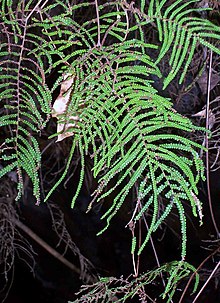Same thing
| Same thing | ||||||||||||
|---|---|---|---|---|---|---|---|---|---|---|---|---|

Gleicheniaceae: Dicranopteris linearis |
||||||||||||
| Systematics | ||||||||||||
|
||||||||||||
| Scientific name | ||||||||||||
| Same thing | ||||||||||||
| link |
The Gleicheniales are an order of the true ferns (Polypodiopsida).
features
The Gleicheniales have relatively few common features, but are well characterized as a monophyletic group by molecular biological studies. The stelae of the roots have three to five proto xylem poles. The antheridia have six to twelve twisted or curved cells in the antheridia wall.
Occurrence
The Gleicheniales occur in the entire tropics and partly in the subtropics.
Systematics
The Gleicheniales are more at the base of the leptosporangiate ferns. They are monophyletic and the sister group of the skin ferns .




Today the Gleicheniales are divided into three families:
-
Gleicheniaceae : They are characterized by forked (pseudodichotom) divided leaves . The rhizome has a protostele, the leaf veins end freely, the sori are on the underside of the leaf, not on the edge, and consist of five to 15 sporangia with a transverse annulus and 128 to 800 spores . The sporangia in a sorus ripen simultaneously. The gametophyte is green, has club-shaped hair and lives on the surface. The basic chromosome number is x = 22, 34, 39, 43 or 56. There are around 125 species with the following genera:
- Dicranopteris Bernh. , with about 10–17 species.
- Diplopterygium (Diels) Nakai , with about 20 species in Asia and the western Pacific.
-
Gleichenella Ching , with only one species in northern South America :
- Gleichenella pectinata (Willd.) Ching
- Gleichenia Sm. , With at least 12 species in South Africa , the Mascarene Islands and between Malesia, Australia and New Zealand.
-
Sticherus C. Presl , with at least 62 species, including:
- Fächerfarn ( Sticherus flabellatus (R. Br.) H. St.John ) located in Australia , Tasmania , New Zealand and New Caledonia occurs.
- Stromatopteris Mett. , with only one species in New Caledonia:
-
Dipteridaceae : The family is native to India , Southeast Asia, China , Japan , Malesia to West Polynesia ( Samoa ). It is monophyletic and fossil known since the Upper Triassic . They have a long creeping trunk. The petiole has a single vascular bundle . The leaf blades are divided into two or more unequal parts. The Sori have no indusium. The annulus of the sporangium is vertical or slightly inclined, the simultaneously or successively ripening sporangia form 64 or 128 spores each. The gametophytes are a heart-shaped thallus . The basic chromosome number is x = 33. The two genera contain around 6–11 species:
-
Cheiropleuria C. Presl , with probably only one species that occurs in East Asia:
- Cheiropleuria bicuspis (flower) C. Presl
- Dipteris Reinw. , with about 5–8 species from Asia to Polynesia .
-
Cheiropleuria C. Presl , with probably only one species that occurs in East Asia:
-
Matoniaceae : They are native to the Malay-Pacific region and have been known in fossil form since the Middle Mesozoic. The trunk has a Solenostele with at least two concentric vascular bundle cylinders. The leaf blades are unequally dichotomously branched. The Sori have an indusium . The sporangia ripen at the same time, have a short stalk and an oblique annulus. The gametophyte is green, thallus-shaped and with large, multicellular antheridia. There are two genera with two types each:
- Matonia R. Br. Ex Wall. , with about two species in Malesia .
- Phanerosorus Copel. , with up to two species that occur on Borneo and New Guinea .
The Gleicheniales have been known to fossils since the Jurassic . They reached their greatest biodiversity in the Mesozoic .
literature
- Alan R. Smith, Kathleen M. Pryer, Eric Schuettpelz, Petra Korall, Harald Schneider, Paul G. Wolf: A classification for extant ferns. In: Taxon. Volume 55, No. 3, 2006, ISSN 0040-0262 , pp. 705-731 ( abstract, PDF file ).
- Kathleen M. Pryer, Eric Schuettpelz, Paul G. Wolf, Harald Schneider, Alan R. Smith, Raymond Cranfill: Phylogeny and evolution of ferns (Monilophytes) with a focus on the early leptosporangiate divergences. In: American Journal of Botany. Volume 91, No. 10, 2004, pp. 1582-1598, doi: 10.3732 / ajb.91.10.1582 .
- Clifton E. Nauman: Gleicheniaceae. In: Flora of North America Editorial Committee (Ed.): Flora of North America North of Mexico . Volume 2: Pteridophytes and Gymnosperms . Oxford University Press, New York / Oxford a. a. 1993, ISBN 0-19-508242-7 , pp. 100–101 (English, limited preview in Google Book Search - online ).
- David John Mabberley: The Plant Book. A portable dictionary of the higher plants . Cambridge University Press, Cambridge u. a. 1987, ISBN 0-521-34060-8 .
- Walter Erhardt , Erich Götz, Nils Bödeker, Siegmund Seybold: The great pikeperch. Encyclopedia of Plant Names. Volume 2. Types and varieties. Eugen Ulmer, Stuttgart (Hohenheim) 2008, ISBN 978-3-8001-5406-7 .